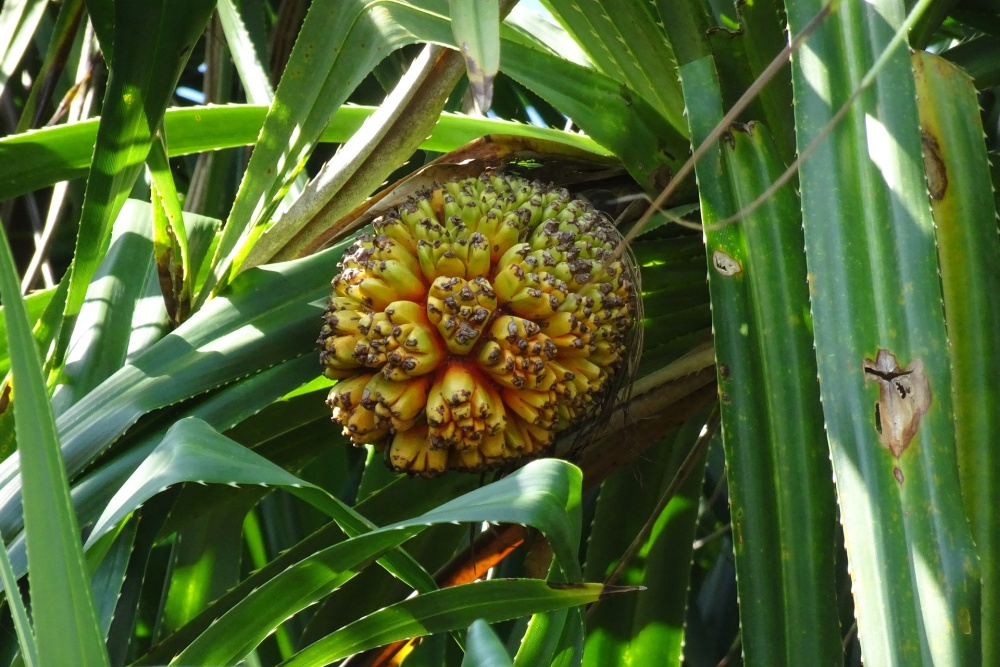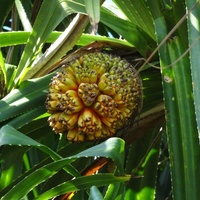Common name: Kewra
Other common names: Hala, Screwpine, Umbrella tree
Description
Kewra or Screwpine is an essential-oil yielding plant originating in the Old World tropics, its natural range extending from coastal parts of eastern India and the Andaman Islands, through coastal Burma and Indonesia to Melanesia.
Although widespread in the wild, it is cultivated for its essential oil only in parts of its native range, particularly in and around the Ganjam district in the Indian state of Odisha (formerly Orissa), situated on the Bay of Bengal.
It is a moderately slow-growing, shrubby plant up to 6 m (20 ft) tall, with a single or multiple semi-woody stems having aerial roots, making the whole plant appear as if on stilts.
The stems are slim and erect, though sometimes curved by wind and branch to form a dense, irregular-shaped, sometimes rounded crown. The bark is grey-brown and ringed by leaf scars.
It has a clumping habit, sending up suckers from the roots, causing dense stands or thickets to form over time.
Leaves are sword-shaped, 1 to 1.5 m (3.2 to 5 ft) long, usually blue-green, though variegated forms occur, and armed with short, sharp spines along the margins and mid-rib. They are spirally arranged at the ends of the branches and droop. Being evergreen, they remain on the plant year-round.
The flowers are either female or male, borne on separate plants. Female plants have flowers in small, greenish pineapple-like clusters about 5 cm (2 in) in diameter.
Male flowers are small, white, sweetly fragrant and tightly packed in branched clusters grouped on a slim flower spike 25 to 50 cm (0.8 to 1.6 ft) long. The spike sits within creamy-white bracts that spread apart when fully developed, revealing the flowers. They bloom in the rainy season, which coincides with the summer or monsoon season in its native range.
Fertilised female flowers develop into a pineapple-shaped, compound fruit consisting of the fruit of several flowers. It takes two years to mature, becoming yellow or red-orange and is large, with a diameter of up to 25 cm (10 in).

Photo by Bishnu Sarangi from Pixabay
Use
The sweetly fragrant male flowers are steam distilled using separate processes to produce 'Kewra water', 'Kewra attar' and 'Kewra oil'.
Kewra water is used as a flavouring in syrups, cordials, soft drinks and confectionery, particularly Indian sweets. Kewra attar, in contrast, is used as a fragrance and fixative in Ittars, the water-based (alcohol-free) perfumes of India and the Middle East, and to scent creams, lotions and soap, as well as for incense and to flavour tobacco products. Kewra oil has health-giving benefits (see below).
The male flower spikes are harvested early in the morning with the bracts intact and care taken not to bruise them. They are then transported to the distillery within a few hours, as too long storage causes deterioration in the oil quality. Around 1,000 spikes are needed to produce 18 kgs of Kewra water, 1,000 to 10,000 spikes to produce 1 kg of Kewra attar, depending on the grade required, and 100,000 spikes to produce 1 kg of Kewra oil.
The young leaves are added whole to rice dishes to impart their aroma and flavour.
The mature leaves yield an excellent fibre commonly woven into baskets, mats, decorative boxes, hats, sandals and other valuable articles. After harvesting the leaves, the spines and thin outer layer are removed, leaving the fibrous interior, which is then stripped into long strands. The strands are then dyed and sun-dried to produce the finished fibre.
The plant tolerates seasonal and tidal flooding, including brackish and saline water conditions. It is suitable for coastal plantings and various coastal protection services, including sand and soil stabilisation, general erosion prevention, land reclamation, and serving as a coastal windbreak or barrier.
Health use
Kewra oil is used in traditional Indian (Ayurvedic) medicine as a stimulant and antispasmodic to treat headaches and rheumatism.
Climate
It grows naturally in moderately humid, tropical coastal climates, generally frost-free areas with annual lows of 20 to 25°C, annual highs of 28 to 35°C, annual rainfall of 1000 to 4600 mm and a dry season of 3 to 7 months.
Growing
New plants are usually started from branch cuttings or suckers taken from selected plants, as seedlings do not always inherit the parent plant's characteristics. Only male plants are chosen for cuttings and suckers, as only male flowers are distilled for their essential oil. Planting is carried out at the start of the rainy season in its native range.
Performs best on free-draining clay, loam and sand soils of a slightly acid to alkaline nature, generally with a pH of 6 to 10, and on sites with full to partial sun exposure. It has good tolerance to a range of adverse growing conditions, including those already mentioned above, as well as drought.
Male plants start producing flowers when they are around five years old and remain productive for up to twenty-five years.
Problem features
It is listed as a weed in at least one reference publication. Still, there does not appear to be any record of it as a serious weed anywhere, despite its widespread distribution.
The leaves are armed with sharp spines that can inflict injury.
Where it grows
References
Books
-
Dey, S.C. 1996, Fragrant flowers for homes and gardens, trade and industry, Abhinav Publications, New Delhi, India
-
Farooqi, A. A. & Sreeramu, B. S. 2004, Cultivation of medicinal and aromatic crops, Hyderabad University Press, Hyderabad
-
Groom, N. 1997, The new perfume handbook, 2nd ed., Blackie Academic & Professional, London
-
Hunter, N. T & Mitchell, H. 1994, The art of floral design, Delmar Publishers, Albany, New York
-
Kochhar, S. L 1998, Economic botany in the tropics, 2nd ed, Macmillan India, Delhi
-
Parrotta, J. A. 2001, Healing plants of peninsular India, CABI Publishing, Wallingford, Oxfordshire
-
Seidemann, J. 2005, World spice plants: economic usage botany taxonomy, Springer-Verlag, Berlin
-
Selvam, V. 2007, Trees and shrubs of the Maldives, Food and Agriculture Organisation (FAO) RAP publication (Maldives), Thammada Press Company Ltd., Bangkok
Articles, Journals, Reports and Working Papers
-
National Research Council (Board on Science and Technology for International Development) 1990, Saline agriculture : salt-tolerant plants for developing countries, The National Academies Press, Washington D. C.


